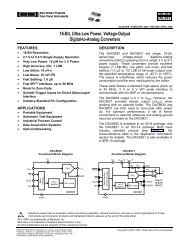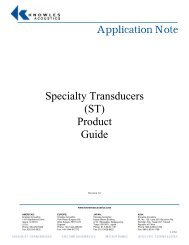AD7714* 3 V/5 V, CMOS, 500 µA Signal Conditioning ADC - dreamm
AD7714* 3 V/5 V, CMOS, 500 µA Signal Conditioning ADC - dreamm
AD7714* 3 V/5 V, CMOS, 500 µA Signal Conditioning ADC - dreamm
Create successful ePaper yourself
Turn your PDF publications into a flip-book with our unique Google optimized e-Paper software.
System-Offset Calibration<br />
System-offset calibration is a variation of both the system calibration<br />
and self-calibration. In this case, the zero-scale point is<br />
determined in exactly the same way as a ZS System Calibration.<br />
The system zero-scale point is presented to the AIN inputs of<br />
the converter. This must be applied to the converter before<br />
the calibration step is initiated and remain stable until the step<br />
is complete. Once the system zero scale has been set up, a<br />
System-Offset Calibration is then initiated by writing the appropriate<br />
values (1, 0, 0) to the MD2, MD1 and MD0 bits of the<br />
Mode Register. The zero-scale system calibration is performed<br />
at the selected gain.<br />
The full-scale calibration is performed in exactly the same way<br />
as an FS Self Calibration. The full-scale calibration conversion<br />
is performed at the selected gain on an internally generated voltage<br />
of V REF /Selected Gain. This is a one step calibration<br />
sequence and the time for calibration is 6 × 1/Output Rate. At<br />
this time, the MD2, MD1 and MD0 bits in the Mode Register<br />
return to 0, 0, 0. This gives the earliest indication that the calibration<br />
sequence is complete. The DRDY line goes high when<br />
calibration is initiated and does not return low until there is a<br />
valid new word in the data register. The duration time from the<br />
calibration command being issued to DRDY going low is 9 × 1/<br />
Output Rate. This is made up of 3 × 1/Output Rate for the zeroscale<br />
system calibration, 3 × 1/Output Rate for the full-scale<br />
self-calibration and 3 × 1/Output Rate for a conversion on the<br />
analog input. This conversion on the analog input is on the<br />
same voltage as the zero-scale system calibration and, therefore,<br />
the resultant word in the data register from this conversion<br />
should be a zero-scale reading. If DRDY is low before (or goes<br />
low during) the calibration command write to the Mode Register,<br />
it may take up to one modulator cycle (MCLK IN/128)<br />
before DRDY goes high to indicate that calibration is in<br />
progress. Therefore, DRDY should be ignored for up to one<br />
modulator cycle after the last bit of the calibration command is<br />
written to the Mode Register.<br />
In the unipolar mode, the system-offset calibration is performed<br />
between the two end-points of the transfer function; in the<br />
bipolar mode, it is performed between midscale and positive full<br />
scale.<br />
Background Calibration<br />
The AD7714 also offers a background calibration mode where<br />
the part interleaves its calibration procedure with its normal<br />
conversion sequence. In the background calibration mode, the<br />
part provides continuous zero-scale self-calibrations; it does not<br />
provide any full-scale calibrations. The zero-scale point used in<br />
determining the calibration coefficients in this mode is exactly<br />
the same as for a ZS Self-Calibration. The background calibration<br />
mode is invoked by writing 1, 0, 1 to the MD2, MD1,<br />
MD0 bits of the Mode Register. When invoked, the background<br />
calibration mode performs a zero-scale self calibration<br />
after every output update and this reduces the output data rate<br />
of the AD7714 by a factor of six. Its advantage is that the part<br />
is continually performing offset calibrations and automatically<br />
updating its zero-scale calibration coefficients. As a result, the<br />
effects of temperature drift, supply sensitivity and time drift on<br />
zero-scale errors are automatically removed. When the background<br />
calibration mode is turned on, the part will remain in<br />
this mode until bits MD2, MD1 and MD0 of the Mode Register<br />
are changed.<br />
AD7714<br />
Because the background calibration does not perform full-scale<br />
calibrations, a self-calibration should be performed before placing<br />
the part in background calibration mode. Removal of the<br />
offset drift in this mode leaves gain drift as the only source of<br />
error not removed from the part. The typical gain drift of the<br />
AD7714 with temperature is 0.2 ppm/°C. The SYNC input or<br />
FSYNC bit should not be exercised when the part is in background<br />
calibration mode.<br />
Span and Offset Limits<br />
Whenever a system calibration mode is used, there are limits on<br />
the amount of offset and span which can be accommodated.<br />
The overriding requirement in determining the amount of offset<br />
and gain which can be accommodated by the part is the requirement<br />
that the positive full-scale calibration limit is ≤ 1.05 ×<br />
V REF /GAIN. This allows the input range to go 5% above the<br />
nominal range. The in-built headroom in the AD7714’s analog<br />
modulator ensures that the part will still operate correctly with a<br />
positive full-scale voltage which is 5% beyond the nominal.<br />
The range of input span in both the unipolar and bipolar modes<br />
has a minimum value of 0.8 × V REF /GAIN and a maximum<br />
value of 2.1 × V REF /GAIN. However, the span (which is the difference<br />
between the bottom of the AD7714’s input range and<br />
the top of its input range) has to take into account the limitation<br />
on the positive full-scale voltage. The amount of offset which<br />
can be accommodated depends on whether the unipolar or<br />
bipolar mode is being used. Once again, the offset has to take<br />
into account the limitation on the positive full-scale voltage. In<br />
unipolar mode, there is considerable flexibility in handling negative<br />
(with respect to AIN(–)) offsets. In both unipolar and bipolar<br />
modes, the range of positive offsets which can be handled by<br />
the part depends on the selected span. Therefore, in determining<br />
the limits for system zero-scale and full-scale calibrations,<br />
the user has to ensure that the offset range plus the span range<br />
does exceed 1.05 × V REF /GAIN. This is best illustrated by looking<br />
at a few examples.<br />
If the part is used in unipolar mode with a required span of<br />
0.8 × V REF /GAIN, then the offset range which the system calibration<br />
can handle is from –1.05 × V REF /GAIN to +0.25 × V REF /<br />
GAIN. If the part is used in unipolar mode with a required span of<br />
V REF /GAIN, then the offset range which the system calibration can<br />
handle is from –1.05 × V REF /GAIN to +0.05 × V REF /GAIN. Similarly,<br />
if the part is used in unipolar mode and required to<br />
remove an offset of 0.2 × V REF /GAIN, then the span range<br />
which the system calibration can handle is 0.85 × V REF /GAIN.<br />
If the part is used in bipolar mode with a required span of<br />
±0.4 × V REF /GAIN, then the offset range which the system calibration<br />
can handle is from –0.65 × V REF /GAIN to +0.65 × V REF /<br />
GAIN. If the part is used in bipolar mode with a required span<br />
of ±V REF /GAIN, then the offset range which the system calibration<br />
can handle is from –0.05 × V REF /GAIN to +0.05 × V REF /<br />
GAIN. Similarly, if the part is used in bipolar mode and<br />
required to remove an offset of ±0.2 × V REF /GAIN, then the<br />
span range which the system calibration can handle is<br />
±0.85 × V REF /GAIN.<br />
2<br />
REV. B –23–















